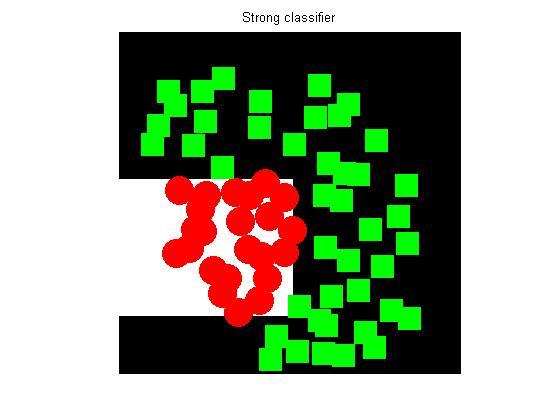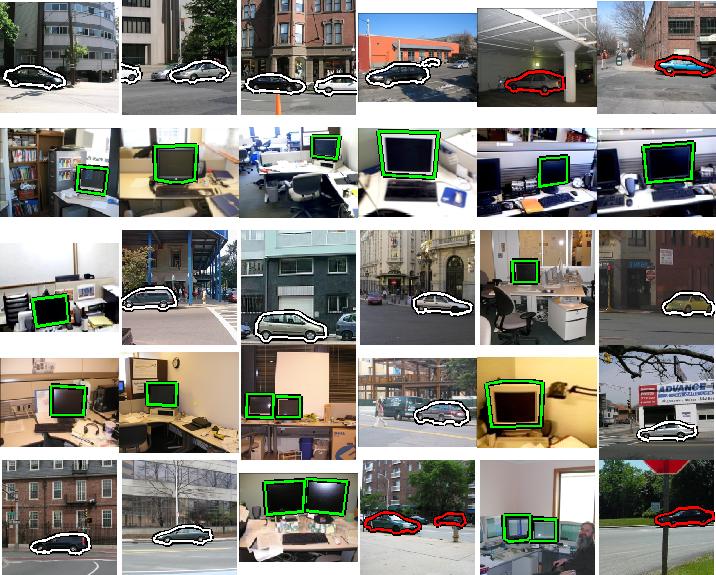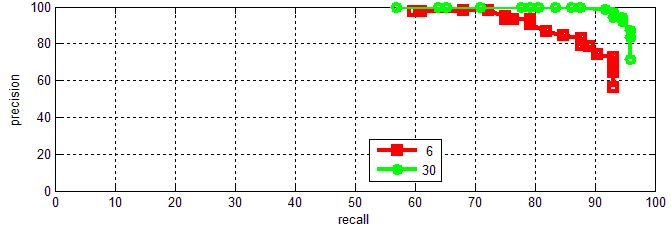Discriminatively Trained Deformable Part Models
Version 4. Updated on April 21, 2010.


Over the past few years we have developed a complete learning-based system for detecting and localizing objects in images. Our system represents objects using mixtures of deformable part models. These models are trained using a discriminative method that only requires bounding boxes for the objects in an image. The approach leads to efficient object detectors that achieve state of the art results on the PASCAL and INRIA person datasets.At a high level our system can be characterized by the combination of
1) Strong low-level features based on histograms of oriented gradients (HOG).
2) Efficient matching algorithms for deformable part-based models (pictorial structures).
3) Discriminative learning with latent variables (latent SVM).
PASCAL VOC "Lifetime Achievement" Prize
Here you can download a complete implementation of our system. The current implementation extends the system in [2] as described in [3]. The models in this implementation are structured using the grammar formalism presented in [4]. Previous releases are available below.
The distribution contains object detection and model learning code, as well as models trained on the PASCAL and INRIA Person datasets. This release also includes code for rescoring detections based on contextual information.
Also available (as a separate package) is the source code for a cascade version of the object detection system, which is described in [5].The system is implemented in Matlab, with a few helper functions written in C/C++ for efficiency reasons. The software was tested on several versions of Linux and Mac OS X using Matlab versions R2009b and R2010a. There may be compatibility issues with other versions of Matlab.
For questions regarding the source code please contact Ross Girshick at r...@cs.uchicago.edu (click the "..." to reveal the email address).
Source code and model download: voc-release4.tgz (updated on 04/21/10).
Warning: fconvblas.cc does not work with matlab 2010b. You should use fconv.cc or fconvMT.cc (see compile.m).
Cascade detection code: here
This project has been supported by the National Science Foundation under Grant No. 0534820, 0746569 and 0811340.
ReferencesSlides from a presentation given at the 2009 Chicago Machine Learning Summer School and Workshop pdf.
[1] P. Felzenszwalb, D. McAllester, D. Ramaman.
A Discriminatively Trained, Multiscale, Deformable Part Model.
Proceedings of the IEEE CVPR 2008.
[2] P. Felzenszwalb, R. Girshick, D. McAllester, D. Ramanan.
Object Detection with Discriminatively Trained Part Based Models.
IEEE Transactions on Pattern Analysis and Machine Intelligence, Vol. 32, No. 9, September 2010
pdf
[3] R. Girshick, P. Felzenszwalb, D. McAllester.
release4-notes.pdf -- also included in the download.
[4] P. Felzenszwalb, D. McAllester.
Object Detection Grammars.
University of Chicago, Computer Science TR-2010-02, February 2010.
pdf
[5] P. Felzenszwalb, R. Girshick, D. McAllester.
Cascade Object Detection with Deformable Part Models.
Proceedings of the IEEE CVPR 2010.
pdf
How to cite
When citing our system, please cite reference [2] and the website for the specific release. The website bibtex reference is below.
@misc{voc-release4,
author = "Felzenszwalb, P. F. and Girshick, R. B. and McAllester, D.",
title = "Discriminatively Trained Deformable Part Models, Release 4",
howpublished = "http://people.cs.uchicago.edu/~pff/latent-release4/"}
Example detections


Detection results — PASCAL datasetsThe models included with the source code were trained on the train+val dataset from each year and evaluated on the corresponding test dataset.
This is exactly the protocol of the "comp3" competition. Below are the average precision scores we obtain in each category.
Table 1. PASCAL VOC 2009 comp3
| aero | bicycle | bird | boat | bottle | bus | car | cat | chair | cow | table | dog | horse | mbike | person | plant | sheep | sofa | train | tv | mean |
| without context | 39.5 |
48.2 |
11.4 |
12.3 |
28.6 |
42.3 |
40.4 |
25.0 |
17.4 |
20.5 |
15.3 |
14.5 |
42.1 |
44.4 |
41.9 |
12.7 |
24.3 |
16.5 |
43.3 |
32.2 |
28.6 |
|---|
| with context | 43.6 |
50.8 |
15.1 |
14.1 |
30.2 |
45.6 |
41.8 |
27.3 |
18.9 |
22.1 |
15.8 |
18.2 |
45.7 |
47.3 |
43.8 |
14.3 |
26.4 |
18.2 |
46.8 |
33.7 |
31.0 |
Table 2. PASCAL VOC 2007 comp3
| aero | bicycle | bird | boat | bottle | bus | car | cat | chair | cow | table | dog | horse | mbike | person | plant | sheep | sofa | train | tv | mean |
| without context | 28.9 |
59.5 |
10.0 |
15.2 |
25.5 |
49.6 |
57.9 |
19.3 |
22.4 |
25.2 |
23.3 |
11.1 |
56.8 |
48.7 |
41.9 |
12.2 |
17.8 |
33.6 |
45.1 |
41.6 |
32.3 |
|---|
| with context | 31.2 |
61.5 |
11.9 |
17.4 |
27.0 |
49.1 |
59.6 |
23.1 |
23.0 |
26.3 |
24.9 |
12.9 |
60.1 |
51.0 |
43.2 |
13.4 |
18.8 |
36.2 |
49.1 |
43.0 |
34.1 |
Table 3. PASCAL VOC 2006 comp3
| bicycle | bus | car | cat | cow | dog | horse | mbike | person | sheep | mean |
| without context | 67.1 |
65.8 |
70.7 |
26.8 |
47.7 |
15.8 |
48.3 |
66.0 |
41.0 |
45.6 |
49.5 |
|---|
| with context | 69.2 |
67.6 |
71.5 |
29.0 |
51.4 |
19.4 |
54.0 |
70.0 |
44.3 |
47.4 |
52.4 |
Detection Results — INRIA PersonWe also trained and tested a model on the INRIA Person dataset.
We scored the model using the PASCAL evaluation methodology in the complete test dataset, including images without people.
INRIA Person average precision: 88.2
Plot of Recall / False positives per image (FPPI):

Previous Releases
voc-release3
voc-release2
voc-release1
back to pff's homepage






 itistory-photo-1
itistory-photo-1 12_859_721_Automatically_Mining_Person_M.pdf
12_859_721_Automatically_Mining_Person_M.pdf




